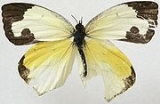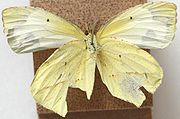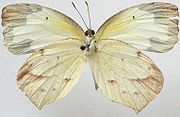
Eurema mexicana
Encyclopedia
The Mexican Yellow is a North
and South America
n butterfly
in the family Pieridae
. It occurs mainly in Mexico
but occasionally is found in central and southwestern USA and rarely in Canada
.

 The upper side of the wings is pale yellow with a black fore wing submarginal border outlining a "dog" or "wolf-face" pattern. The hind wing has a small outer margin black border. The male has a bright yellow patch on the leading edge of the hind wing. The underside of the wings is pale yellow in summer individuals and pale yellow with reddish markings or all reddish-pink in winter individuals. The hind wing is sharply pointed. The wingspan measures 1¼ to 2¼ inches or 33-44 mm.
The upper side of the wings is pale yellow with a black fore wing submarginal border outlining a "dog" or "wolf-face" pattern. The hind wing has a small outer margin black border. The male has a bright yellow patch on the leading edge of the hind wing. The underside of the wings is pale yellow in summer individuals and pale yellow with reddish markings or all reddish-pink in winter individuals. The hind wing is sharply pointed. The wingspan measures 1¼ to 2¼ inches or 33-44 mm.
) and the Salome Yellow (Eurema salome
).
Boisduval's Yellow is smaller and brighter yellow, the male has a weaker "dog face" pattern, the female has reduced black on the upper side, and the hind wing is less sharply pointed.
The Salome Yellow is brighter yellow, has more limited black on the upper side, and the underside of the hind wing has a round reddish spot near the trailing edge.
and Texas
, and April to November in New Mexico
. It strays northward in late summer, rarely reaching Canada
.
s per year.
North America
North America is a continent wholly within the Northern Hemisphere and almost wholly within the Western Hemisphere. It is also considered a northern subcontinent of the Americas...
and South America
South America
South America is a continent situated in the Western Hemisphere, mostly in the Southern Hemisphere, with a relatively small portion in the Northern Hemisphere. The continent is also considered a subcontinent of the Americas. It is bordered on the west by the Pacific Ocean and on the north and east...
n butterfly
Butterfly
A butterfly is a mainly day-flying insect of the order Lepidoptera, which includes the butterflies and moths. Like other holometabolous insects, the butterfly's life cycle consists of four parts: egg, larva, pupa and adult. Most species are diurnal. Butterflies have large, often brightly coloured...
in the family Pieridae
Pieridae
The Pieridae are a large family of butterflies with about 76 genera containing approximately 1,100 species, mostly from tropical Africa and Asia. Most pierid butterflies are white, yellow or orange in coloration, often with black spots...
. It occurs mainly in Mexico
Mexico
The United Mexican States , commonly known as Mexico , is a federal constitutional republic in North America. It is bordered on the north by the United States; on the south and west by the Pacific Ocean; on the southeast by Guatemala, Belize, and the Caribbean Sea; and on the east by the Gulf of...
but occasionally is found in central and southwestern USA and rarely in Canada
Canada
Canada is a North American country consisting of ten provinces and three territories. Located in the northern part of the continent, it extends from the Atlantic Ocean in the east to the Pacific Ocean in the west, and northward into the Arctic Ocean...
.
Description


Similar species
Similar species in the Mexican Yellow's range include Boisduval's Yellow (Eurema boisduvalianaEurema boisduvaliana
Eurema boisduvaliana, Boisduval's Yellow, is a butterfly in the Pieridae family. It is found from Costa Rica north to Mexico. Rare strays may be found in southern Florida, but it is a regular migrant to south-eastern Arizona, south-western New Mexico, and southern Texas...
) and the Salome Yellow (Eurema salome
Eurema salome
Eurema salome, the Salome Yellow, is a butterfly in the Pieridae family. It is found from Peru northward through tropical America. It is an extremely rare migrant to the lower Rio Grande Valley in Texas. The habitat consists of forest openings and edges and roadcuts.The wingspan is...
).
Boisduval's Yellow is smaller and brighter yellow, the male has a weaker "dog face" pattern, the female has reduced black on the upper side, and the hind wing is less sharply pointed.
The Salome Yellow is brighter yellow, has more limited black on the upper side, and the underside of the hind wing has a round reddish spot near the trailing edge.
Habitat
The Mexican Yellow lives in a variety of open habitats such as woodland edges, open woodlands, and desert grasslands.Flight
This butterfly may be seen almost all year in ArizonaArizona
Arizona ; is a state located in the southwestern region of the United States. It is also part of the western United States and the mountain west. The capital and largest city is Phoenix...
and Texas
Texas
Texas is the second largest U.S. state by both area and population, and the largest state by area in the contiguous United States.The name, based on the Caddo word "Tejas" meaning "friends" or "allies", was applied by the Spanish to the Caddo themselves and to the region of their settlement in...
, and April to November in New Mexico
New Mexico
New Mexico is a state located in the southwest and western regions of the United States. New Mexico is also usually considered one of the Mountain States. With a population density of 16 per square mile, New Mexico is the sixth-most sparsely inhabited U.S...
. It strays northward in late summer, rarely reaching Canada
Canada
Canada is a North American country consisting of ten provinces and three territories. Located in the northern part of the continent, it extends from the Atlantic Ocean in the east to the Pacific Ocean in the west, and northward into the Arctic Ocean...
.
Life cycle
Males will patrol all day looking for females. The larva is green with a middorsal creamy or yellow stripe and a lateral yellow stripe. The Mexican Yellow has 3-4 broodOffspring
In biology, offspring is the product of reproduction, of a new organism produced by one or more parents.Collective offspring may be known as a brood or progeny in a more general way...
s per year.
Host plants
Here is a list of host plants used by the Mexican Yellow:- New Mexican Locust, Robinia neomexicana
- Fern Acacia, Acacia angustissimaAcacia angustissimaAcacia angustissima is a perennial, deciduous, shrub or tree in the Fabaceae family native to Central America and the United States. It is also found in South America, India and Pakistan. Other common names for it include Carboncillo, Timbe, Timbre, Fern Acacia and Prairie wattle...
- Prairie Acacia, Acacia angustissimaAcacia angustissimaAcacia angustissima is a perennial, deciduous, shrub or tree in the Fabaceae family native to Central America and the United States. It is also found in South America, India and Pakistan. Other common names for it include Carboncillo, Timbe, Timbre, Fern Acacia and Prairie wattle...
var. hirta - CassiaCassiaCinnamomum aromaticum, called cassia or Chinese cinnamon, is an evergreen tree native to southern China, Bangladesh, Uganda, India, and Vietnam. Like its close relative Cinnamomum verum, also known as "Ceylon cinnamon", it is used primarily for its aromatic bark, which is used as a spice...
species - Diphysa robinoides.

